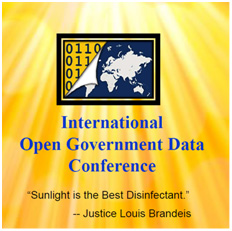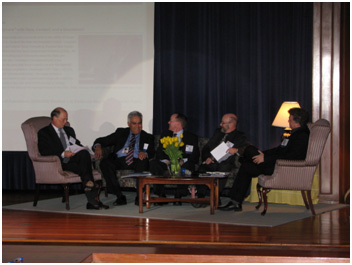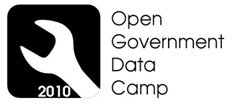"Think Globally - Act Locally"- A New Chapter for Data.gov...
Data.gov Team Moves to New Location
As this is posted today, the Data.gov team has re-located to our new “greener” General Services Administration (GSA) building in One Constitution Square in Northeast Washington, D.C. These new surroundings, optimized for open collaboration, are filled with new opportunities and possibilities. This new work environment epitomizes the key characteristics of the Data.gov team – nimble, collaborative, adaptive, and forward-leaning (to new horizons)! Our physical address may have changed but our digital, virtual addresses (e-mail, phone, PDA, and web) in the digital domain remain the same as our transition was seamless and flawless.

The International Open Government Data Conference (IOGDC) was a Rousing Success!

By all accounts and feedback, the International Open Government Data Conference (IOGDC) held in November in Washington DC was a rousing success! It attracted nearly 400 people from around the world to discuss, explore, and celebrate the great strides taken in opening up government data. From Australia to the United Kingdom, from Poland to Vietnam, experts shared the lessons they had learned in creating open data movements, developing apps, and analyzing government data. Many thanks to everyone who attended and made those three days such a rich experience for all of us.
Data.gov sponsored the conference to bring together so many of the people who have been meeting independently in this area. Recently, developers have been hosting and attending “hack-a-thons” and “mash-a-thons.” Government executives have been meeting to formulate policy decisions. Security experts have been investigating the issues related to the release of data. But … these have happened independent of each other. The IOGDC brought many of these people together to share the conversation and shape the vision for the future of open government data.
We converged on the U.S. Department of Commerce auditorium, we shared knowledge formally and informally—believe it or not, open government data people are incredibly passionate and committed about their work—and we launched a new community among those committed to using and making available government data worldwide. Check out the postings in the community site or review the “blow-by-blow” events from the >1,700 tweets on #IOGDC!

Dan Melton of Code for America captured the passion of conference participants!

I appreciated the participation and perspectives of visionaries U.S. Government Chief Information Officer Mr. Vivek Kundra and World Wide Web inventor Sir Tim Berners-Lee at the IOGDC
Open Government Data Perspectives and Progress around the Globe were Illuminating

Dave McClure from GSA, myself, Richard Best from New Zealand, Trevor Smallwood from Australia, and Stephen Walker from Canada sharing lessons learned about open government data implementations.
Nearly 400 participants came from 5 continents, 13 nations, and 31 federal agencies. It was evident that a lot of progress has been made in the U.S. and abroad since the launch of the Open Government Initiative and Open Government Directive (OGD) and Data.gov in 2009. The paradigm shift from “protect everything and share what you must” to “share everything and protect what you must” (but still comply with National Security, Privacy and Information Quality Regulations) based on the President’s vision and the Attorney General guidelines were important to the open data movement and phenomenon. Hearing about the great work by each of the government organizations in the U.S. and abroad was the highlight of the conference. The progress was palpable and measurable.
You should check out the amazing progress made by the participant countries and how they are addressing challenges and opportunities with pragmatic solutions:
- Protecting Security and Safeguarding Privacy in the Age of Open Government: Office of the Director of National Intelligence (ODNI), GSA, Office of Management and Budget (OMB), and Australia*
- Data Sharing to Solve Mission Problems—Are We Doing Enough?: U.S. Environmental Protection Agency (EPA), Johns Hopkins University, and GSA
- The Semantic Web—What is it? Is it Ready for Prime-Time? And How Can I Use It?: Rensselaer Polytechnic Institute (RPI), U.S. Department of Health and Human Services (HHS), GSA and United Kingdom*
- Putting Data to Work—Creating Value-Added Functionality and Applications Through Mash-ups: RPI, U.S. National Renewable Energy Laboratory, U.S. National Institutes of Health, and GSA
- Harnessing Data to Inspire and Inform: Code for America and New York Times
- Building a Blueprint for Collaboration—A Healthy Approach to Open Data: ODNI, HHS, and GSA
- On the Road Again—Data Available Anytime, Anywhere Through Mobile Apps: University of Illinois Urbana-Champaign, GSA, and RPI
- Case Study on Data.gov: Harvard Business School, Harvard University
- What is Value Proposition of Open Government Data? How Do We Measure Success?:U.S. Department of Interior (DOI), University at Albany, O’Reilly Media, and United Nations*
- Technologies for Transparency—Dynamic Open Data Publishing with Open APIs: Clark & Parsia LLC, Code for America, New York Times, HHS, and U.S. National Aeronautics and Space Agency (NASA)
- Enabling Geospatial Killer Apps—Interfaces, Visualizations and APIs—Imaging the World: GSA, U.S. Geological Survey (DOI), and EPA
- How To Create A Vibrant Open Data Community: U.S. Department of Education, U.S. Department of State, Sunlight Foundation, and GSA
- Open Government Sites—Where We Have Been and Where We Are Going: New York State Senate, GSA, and Brazil*
- Working Together In Communities of Practice with Metadata Standards: Federal Reserve System, Bureau of Labor Statistics, and OMB
- International Open Government Data Leaders—Top 10 Issues and Lessons Learned: GSA, United Kingdom, New Zealand, Australia, and Canada*
Senior U.S. leaders from the White House delivered four keynotes with the following themes:
- Data.gov importance to open government and the road ahead
- Government-wide Open Government Directive and open data progress
- Closing the technology gap with platforms and participation to deliver ecosystems focused on results
- The global impact of open data
It is noteworthy that international organizations participated in five of 15 session areas noted above* with equal contributions and important perspectives. Additionally, International organizations led three other sessions with exclusive international perspectives. You should check out the huge strides made by the international organizations, which are embracing Open Government Data and addressing challenges:
- New Zealand and Australia addressing “licensing and ownership of government data”
- New Zealand focused on social media and open data policies
- The U.K. in creating semantically rich datasets on Data.gov.uk
- Brazil for e-democracy and participative government activities
- Australia in making government both secure and transparent
- The United Nations (UN) programs for e-governance that reaches to developed and developing countries
- Canada in opening up both national and provincial data
- The World Bank was very innovative in open development with open data, open knowledge and open solutions. Their “Apps for Development” contest was noteworthy

It is obvious that we are forming a powerful Open Data community across the globe. People have already contacted me about the next IOGDC event based on the incredible amount of positive energy, knowledge sharing, goodwill, and possibility for greater good that was experienced at the conference.
Key Epiphany: At the risk of waxing philosophical, I have observed that we tend to learn from each other continuously. No one has the monopoly on the best ideas. We keep building on each other’s ideas, innovations and success that can become a force multiplier for a greater good! As Spock said, “The needs of the many outweigh the needs of the few or the one.” But you knew that.…
Practice what you preach!
We’ve been practicing what we have been preaching:
- You can find all the speakers listed and presentations here for the three days of amazing discussions! We loaded all the presentations immediately on the Data.gov website and we were lauded by many for our openness, transparency, and quick response
- We participated and coordinated with the Open Government Data Camp: 2010 that took place in London, U.K. that week, speakers traveled from one conference to the other, we cross-posted twitter hash tags, we held discussions in both of the community spaces, and we have created an ongoing series of conversations at multiple levels (policy, technical, developers, and citizens) to grow a truly international view and shared space of open government data.

Finally, we tracked the efforts of the International Open Data “Hack-a-thon” day on December 4, 2010, which attracted thousands of people in over 73 cities on five continents. Application developers from around the world looked at data available from many data.gov sites to create better ways to get information to citizens to make decisions.
Harvard Business Case Study Provides Key Insights on Data.gov

I mentioned last time that Harvard Business School had published a case study about Data.gov. As Data.gov’s senior executive, I was especially proud and pleased to present Harvard Business School (HBS) Assistant Professor Karim Lakhani at the IOGDC, who discussed the recent HBS case study on Data.gov, the full text of which is available on the Data.gov site. Harvard studied Data.gov to better understand Federal CIO Vivek Kundra’s groundbreaking ideas behind it:
- Move government data to the web
- Make data available in raw, machine-readable format
- Encourage people to use the data
- Harness the wisdom of crowds beyond government to drive innovation
What was the result? BETTER GOVERNMENT!
The HBS case study pulls together the best history—word that seems slightly pretentious since we have barely celebrated our first anniversary—of Data.gov from the major players. We have accomplished much in the past year: hosting more than 300,000 datasets, launching apps competitions based on the data, and encouraging use of the data by researchers, developers and the greater public--“putting the data to work” is how we like to describe it. However, the HBS assessment of the way forward is what excites me most.
The HBS case study brings in voices from across the open government data environment, including Ellen Miller from the Sunlight Foundation, Tim O’Reilly of O’Reilly Media, Dave Campbell of Microsoft, along with those of the U.S. Federal government, to discuss Data.gov’s challenges and opportunities. We are in new, uncharted territory. How do we make the most data available while maintaining individual privacy and security? How do we find and assemble a community of experts to create best practices in using U.S. government data? We feel that the recent conference was a big step in this direction.
It’s time to take the open data movement to the next level—we need to create the international communities, topics, and focus areas that need to be addressed as a global community. I encourage you to read this case study and contact me with your ideas—let me know what you’re doing so we can move forward together.
Stay involved and tuned—new communities of data are coming …
Join in the discussions in the open data or semantic communities and stay tuned as new communities in health, economics, climate, and law come to life in the next quarter of fiscal year 2011….
Many on our team will take some much-needed leave this month after working assiduously and continuously for a long while – we shall all re-emerge re-charged, renewed and rejuvenated in 2011! I wish all of you a safe, joyous, and prosperous Holiday Season! Let good data set you free …
Comments
DOT - FRA - FHWA - CWT's
Constant Warning Time (CWT). Circuitry at active warning devices that provides a constant warning time, despite the speed at which a train is approaching... TRB on CWT’s – (1986 Mod. 2006)"Discriminate analysis indicates" that 32,500 Highway–Rail Grade Crossings may require CWT’s, of that 17,685 (2009) have been put into operations, there is another 14,815 CWT's unaccounted for, this is lost data since 2006 modifications and cannot be recovered. I do research on highway-rail grade crossings and I cannot get an answer from anyone on this matter.
Some agencies not fulfilling data promise
I totally support data.gov and its transformative power to make government more open, transparent, accountable, and effective. I want it to succeed! However, as I point out in this blog post, a number of agencies have not posted the "three high-value data sets " as required by the OMB data.gov directive. In fact, that directive stated that these data sets were supposed to be available within 45 days of that order in 2009, and has now been over 450 days.
- Showing 1-3 of 3



RE: Clarification
I want this to work too, however if you play with the numbers, 19,100 highway-rail grade crossings that that were to be equipt with CWT's in 1986 however then it was modified in 2006 for there to be 13,400 additional CWT's with a total of 32,500, the inventories in 2009 was 17,685 CWT’s . So as I said if you play with the numbers from the 19,100 (1986) minus the 17,585 (2009) numbers there is 1, 715 highway-rail grade crossings that were not equipt with the CWT's using the 2009’s inventory, even given the benefit of the doubt to the DOT there has been no data for the 1,715 CWT’s for these grade crossings, not even a location to these grade crossings, this has been going on for the past 25 years if you play with the number but that’s not what this about.